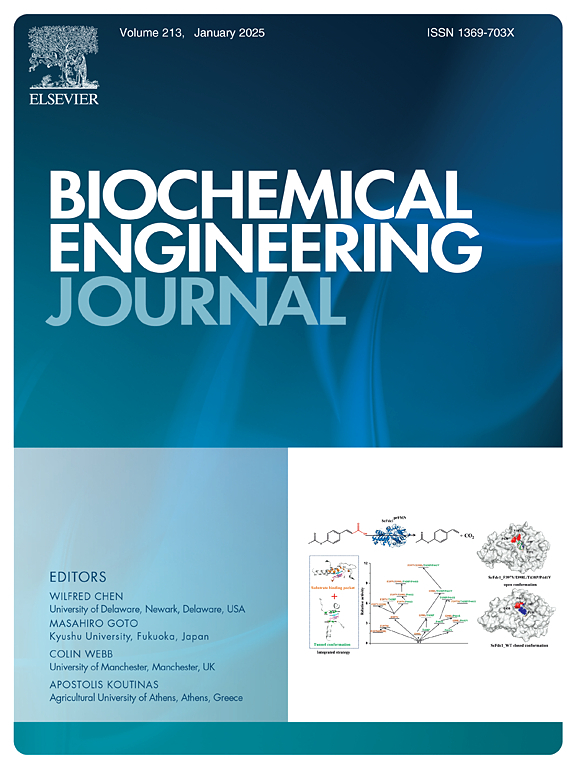Removal of selenate from wastewater using a bioelectrochemical reactor: The importance of measuring selenide and the role of competing anions
IF 3.7
3区 生物学
Q2 BIOTECHNOLOGY & APPLIED MICROBIOLOGY
引用次数: 0
Abstract
Removal of selenate (SeO42-) from selenate-contaminated wastewater is challenging due to the commonly co-existing and competing anions of sulfate (SO42-) and nitrate (NO3-). This study investigates SeO42− reduction to elemental selenium (Se0) in a cathode-based bioelectrochemical (BEC) reactor and a conventional biofilm reactor (i.e., an upflow anaerobic reactor). The simulated wastewater contained SeO42− at a typical concentration of 5 mg Se/L, SO42− at a typical concentration of 1000 mg S/L, and NO3− at concentrations that varied from 0 to 10 mg N/L. The impact of sulfate on the BEC reactor was much lower than that on the conventional reactor: The selenium removal, defined as (selenate in influent – dissolved selenium in effluent)/selenate in influent, was 99 % in the BEC reactor versus 69 % in the conventional biofilm reactor. The lower selenium removal in the conventional reactor was mainly due to the >10 times higher reduction of sulfate, which directly caused competition between sulfate and selenate for the common resources such as electrons. The more reduction of sulfate in the conventional reactor further led to 45 times higher production of selenide. Selenide is usually assumed to be minimal and therefore not measured in the literature. This simplification may significantly overestimate selenium removal when the influent sulfate concentration is very high. NO3- in the influent of the BEC reactor promoted selenium removal when it was less than 5.0 mg N/L but inhibited selenate removal when it was more than 7.5 mg N/L. This was supported by the microbial community analysis and intermediate (nitrite) analysis.
利用生物电化学反应器去除废水中的硒酸盐:测量硒化物的重要性和竞争阴离子的作用
由于硫酸盐(SO42-)和硝酸盐(NO3-)这两种阴离子通常同时存在并相互竞争,因此从硒酸盐污染的废水中去除硒酸盐(SeO42-)具有挑战性。本研究调查了在阴极生物电化学(BEC)反应器和传统生物膜反应器(即上流式厌氧反应器)中将 SeO42- 还原为元素硒(Se0)的情况。模拟废水中 SeO42- 的典型浓度为 5 毫克 Se/升,SO42- 的典型浓度为 1000 毫克 S/升,NO3- 的浓度为 0 至 10 毫克 N/升。硫酸盐对 BEC 反应器的影响远远低于对传统反应器的影响:BEC 反应器的硒去除率为 99%(进水硒酸盐-出水溶解硒)/进水硒酸盐,而传统生物膜反应器的硒去除率为 69%。传统反应器中硒去除率较低的主要原因是硫酸盐的还原率高达 10 倍,这直接导致了硫酸盐和硒酸盐对电子等共同资源的竞争。传统反应器中更多的硫酸盐还原进一步导致硒化物产量增加 45 倍。硒化物通常被假定为极少量,因此文献中没有对其进行测量。当进水硫酸盐浓度很高时,这种简化可能会大大高估硒的去除率。当 BEC 反应器进水中的 NO3- 小于 5.0 毫克 N/L 时,会促进硒的去除,但当 NO3- 大于 7.5 毫克 N/L 时,则会抑制硒的去除。微生物群落分析和中间产物(亚硝酸盐)分析也证实了这一点。
本文章由计算机程序翻译,如有差异,请以英文原文为准。
求助全文
约1分钟内获得全文
求助全文
来源期刊

Biochemical Engineering Journal
工程技术-工程:化工
CiteScore
7.10
自引率
5.10%
发文量
380
审稿时长
34 days
期刊介绍:
The Biochemical Engineering Journal aims to promote progress in the crucial chemical engineering aspects of the development of biological processes associated with everything from raw materials preparation to product recovery relevant to industries as diverse as medical/healthcare, industrial biotechnology, and environmental biotechnology.
The Journal welcomes full length original research papers, short communications, and review papers* in the following research fields:
Biocatalysis (enzyme or microbial) and biotransformations, including immobilized biocatalyst preparation and kinetics
Biosensors and Biodevices including biofabrication and novel fuel cell development
Bioseparations including scale-up and protein refolding/renaturation
Environmental Bioengineering including bioconversion, bioremediation, and microbial fuel cells
Bioreactor Systems including characterization, optimization and scale-up
Bioresources and Biorefinery Engineering including biomass conversion, biofuels, bioenergy, and optimization
Industrial Biotechnology including specialty chemicals, platform chemicals and neutraceuticals
Biomaterials and Tissue Engineering including bioartificial organs, cell encapsulation, and controlled release
Cell Culture Engineering (plant, animal or insect cells) including viral vectors, monoclonal antibodies, recombinant proteins, vaccines, and secondary metabolites
Cell Therapies and Stem Cells including pluripotent, mesenchymal and hematopoietic stem cells; immunotherapies; tissue-specific differentiation; and cryopreservation
Metabolic Engineering, Systems and Synthetic Biology including OMICS, bioinformatics, in silico biology, and metabolic flux analysis
Protein Engineering including enzyme engineering and directed evolution.
 求助内容:
求助内容: 应助结果提醒方式:
应助结果提醒方式:


